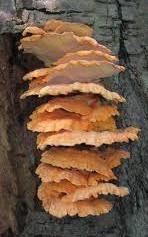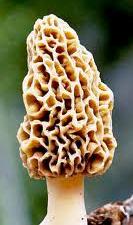
At home, Margie and I stowed the mushroom in the refrigerator for a couple of days. But eventually, we thought we'd try it, and we sautéed it in butter and ate it as instructed. It was tasty. The trouble was, we tend to be nervous people. So after having eaten the mushroom, we began to worry about it. The naturalist had not actually been a mycologist, that is to say a real mushroom expert. Separating poisonous mushrooms from ones that are safe to eat can be a tricky task, and requires a great deal of expertise. I had once read a book on mushrooms, which had stressed the fact that there are no simple tests to distinguish poisonous and nonpoisonous mushrooms. I had once gotten into a bit of a dispute over this issue with a fellow worker at my company. She had stated that her father always tested mushrooms by boiling them together with a silver quarter. If the quarter turned black, the mushroom was poisonous. If the quarter was unaffected, the mushroom was safe to eat. A bit alarmed at hearing this, I noted that the quarter test was not reliable. My fellow worker took umbrage at that remark, essentially saying to me, "Are you calling me a liar?" I said that I was not, and emphasized that I was not myself a mushroom expert. But I did note that I had read a well respected book on mushrooms, and one of the first things it said in its initial chapter was that the quarter test could not be counted upon. I didn't think that quoting the opinion of a well-respected mushroom expert on the subject was equivalent to saying that my fellow employee was lying. It's not accusing someone of lying if you suggest they might be mistaken, and that they might want to do further research on a subject. In any event, back to our sulfur mushroom. Since Margie and I had delayed a few days before eating the mushroom, we figured that other members of the class must have already eaten it. We had a class list, so we started phoning around. However, the class members did not seem to be answering their telephones. Of course, once one starts to get worried about something like this, one can start reading such signs in a pessimistic way. Had they all eaten pieces of the mushroom and died? Why was nobody answering the phone? Finally, someone did answer. "Did you eat the mushroom?", we quickly asked. She replied that she had. But before we could finish breathing a sigh of relief, she added, "I got sick." Our hearts sank. But then she further added, "but I don't think it was the mushroom. I think I just have the flu." We felt better that somebody had eaten the mushroom and had evidently survived. The next few days found us in perfect health. These days, we could simply look the mushroom up on the Internet, and find out everything about it that we could possibly want to know (although some of it might be misinformation). Looking back, it's almost hard to remember the days when we didn't have the World Wide Web to do this with. Had we wanted to do research on "sulfur mushrooms" in those days, it would have taken a trip to the library, and a substantial amount of time spent tracking down appropriate sources. Nowadays, a search on the Internet quickly shows that the sulfur mushroom is an edible mushroom which is so distinctive in its appearance that it really cannot be confused with anything that's poisonous.
Nevertheless, Gibbons did mention a couple of mushrooms which he felt were so easy to identify that they could not possibly be confused with any dangerous species. One of these was the morel (right), and the other was the sulfur mushroom we had eaten. In fact, due to its chicken like texture, the sulfur mushroom is actually sometimes called the "chicken of the woods". The Garden in the Woods naturalist had been very safe in telling us that we could eat it, and we had never been in any danger at all. This was not the first time I had worried about poisoning myself. You might recall one of my earliest blog entries, #0006, The poison apple.
  |
 Around 1971, Margie took a course on wildflowers at the
Around 1971, Margie took a course on wildflowers at the  Indeed, it later turned out that we already had a book in our possession which could have told us this, but we had forgotten about it. It was the very popular book by Euell Gibbons, Stalking the Wild Asparagus. Gibbons was also not a mycologist, and given the difficulties of mushroom identification, he declined to say very much about mushrooms in his book.
Indeed, it later turned out that we already had a book in our possession which could have told us this, but we had forgotten about it. It was the very popular book by Euell Gibbons, Stalking the Wild Asparagus. Gibbons was also not a mycologist, and given the difficulties of mushroom identification, he declined to say very much about mushrooms in his book.